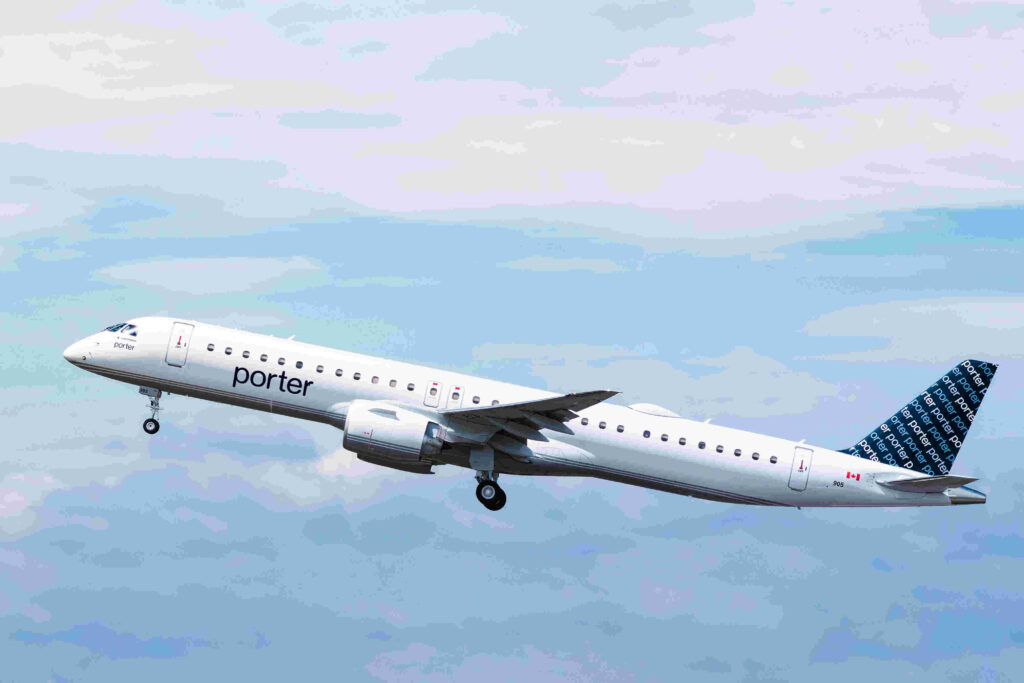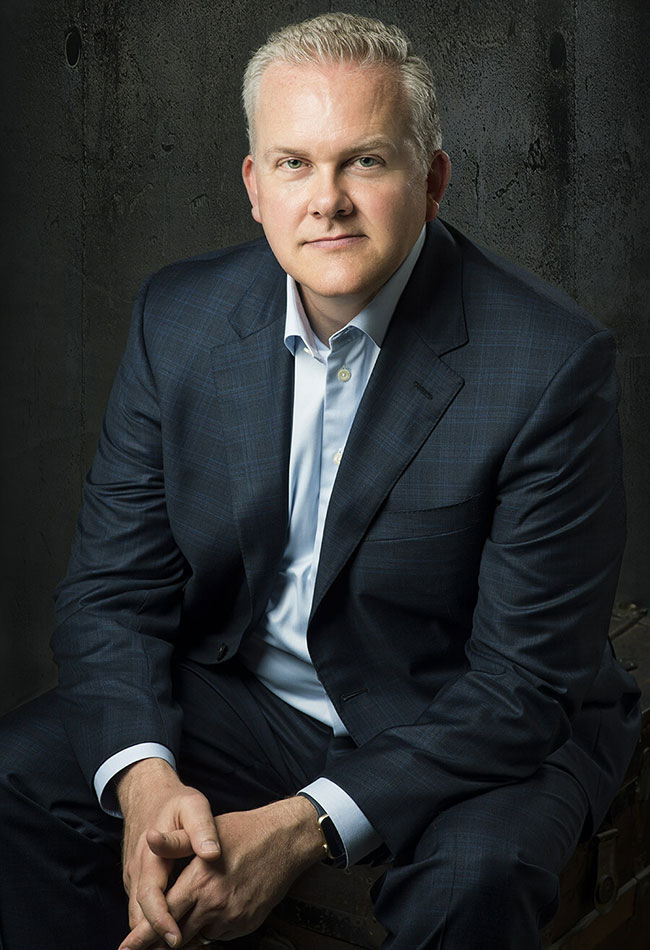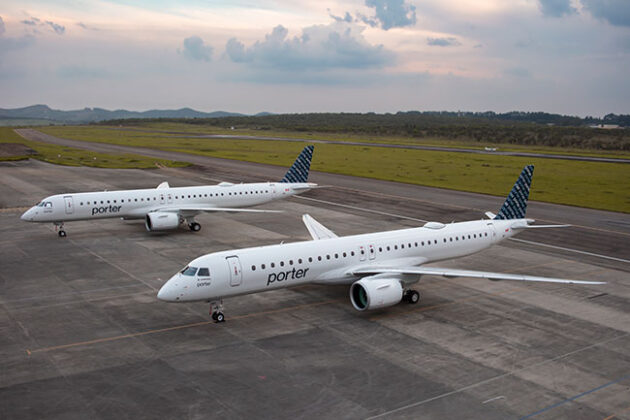
Features
Airlines
Party at Mr. Porter’s House
Inside an industry defining year of transformation and ambitious expansion for Porter Airlines
March 21, 2024 By David Carr
 Porter by December 2023 had doubled the size of its fleet to 58 airplanes and placed an order for another 25 Embraer E195 E2 jetliners. (Photo: Porter Airlines)
Porter by December 2023 had doubled the size of its fleet to 58 airplanes and placed an order for another 25 Embraer E195 E2 jetliners. (Photo: Porter Airlines) A year has literally flown by. In February, Porter Airlines marked the first anniversary of Embraer E195-E2 jet service out of Toronto’s Pearson International Airport (YYZ). Last year, Mr. Porter, the airline’s raccoon mascot, invited a few hundred friends to a house party at a repurposed event space at the popular Toronto Brickworks to celebrate. A pleasing jumble of evergreen, sheds and brick perfect for an urban raccoon. Before British DJ’ing phenom Marsh took to the stage, Wings had a sit down with Kevin Jackson, Porter’s then Chief Commercial Officer, in Mr. Porter’s spacious living room to talk about the year past and what to expect in 2024. (One of the first developments of the New Year, Jackson was appointed President, to oversee Porter’s daily business matters and operations.)
There has been much to celebrate. By December, Porter had doubled the size of its fleet to 58 airplanes, with a matching number of Embraers and De Havilland Dash-8 400s; entered into a transformational tie up with Air Transat; and placed an order for another 25 E195s, bringing its confirmed jet fleet to 75 within a few years, with increased capacity to open routes to Mexico and the Caribbean on the horizon. By the fall, Porter will have added new crew bases for its jets in Ottawa (YOW), Vancouver (YVR) and Montréal (YUL), where it is also building a passenger terminal at the newly rebranded Montréal Metropolitan Airport (YHU, formerly Saint-Hubert Airport) in partnership with Australian-based Macquarie, the world’s largest infrastructure asset management company. When the new terminal opens in 2025, Porter will operate out of both YHU and Montréal Trudeau International (YUL) using both jets and De Havilland Dash-8-400 turboprops.
Porter is bullish on Montréal and will launch new daily service to Calgary, Edmonton and Vancouver this spring. “We think our approach to Montréal can be just like our approach to Toronto where we are successfully serving two airports, YYZ and Billy Bishop [YTZ],” Jackson said. “They have different purposes and a different catchment area. [YHU] will be the most convenient option for half of the city. A lot of passengers will gravitate toward that airport.”

Kevin Jackson in January 2024 was named President of Porter Airlines, where he has been for the past 11 years, after executive positions with America West Airlines and US Airways.
(Photo: Porter Airlines)
Clearly, Porter’s North American expansion has benefitted by WestJet’s and, to a lesser extent, Air Canada’s domestic retreat into their east and west corners. Jackson cautioned about reading too much into that. “WestJet’s exit from eastern Canada just cemented where Porter already was in the marketplace. Even when WestJet was in every single market we served in the east, we were the number two carrier after Air Canada. With the Embraers and the trans-Canada market, we have advanced, so far, out of Toronto and Ottawa. You are now seeing us do that out of other markets and will open deeper into the west as we take on additional aircraft.”
Since launching E195 service on February 1, 2023, Porter has introduced jets on approximately 30 North American routes from a dozen Canadian cities, including Los Angeles, San Francisco and Miami. Porter expects to increase capacity by more than 100 per cent in 2024, as more Embraers arrive. In May, the airline will start E2 service between Toronto and Saskatoon. “We are delivering service and amenities that are unmatched in the industry for economy travellers,” Jackson said.
The E195 is the flagship of the Embraer family of E2 jets. Porter is the only North American airline to fly the airplane, and the largest operator of the type. “The jet is exceeding our expectations, especially in terms of fuel burn,” Michael Deluce, the company’s chief executive said. As a private company, Porter does not publish financials or load factors, but reports that customer satisfaction with the jet network is at 93 per cent. Two-by-two seating by eliminating the dreaded middle-seat being the most popular feature, along with free WiFi and complimentary beer, wine and snacks.
The jet fleet will eclipse the Dash-8s in 2024, and Porter has not ruled out adding turboprops. “As we build up the hubs in eastern Canada, the Dash-8 fleet gives us opportunities to create more feed and build connectivity across eastern Canada,” Jackson says. Porter has Dash-8 bases at its Billy Bishop Airport headquarters, Thunder Bay (YQT), Halifax (YHZ) and Ottawa.
Ottawa was Porter’s first destination when it launched in 2006, and now rivals Air Canada and Chorus (operating as Air Canada Express) as YOW’s busiest carrier. It operates up to 35 daily flights with a mix of E195 and Dash-8s, and is the only airline to offer year-round, coast-to-coast connectivity. YOW is also the only airport outside of Porter’s Toronto hub to fly transborder with Dash-8 service to Boston and Newark. “Passengers are coming into Ottawa and connecting on the E195,” Jackson says. “As we start to intersect the fleets in Montréal and Halifax, the same thing will happen.”
Where the fleet will not intersect, at least for 2024, is Toronto. Despite a convenient rail link between downtown and YYZ, transferring Dash-8 passengers from YTZ would be too much of a hassle. “We are mixing passengers across the two fleets, but we won’t mix them from the Island. It’s just not competitive,” Jackson insists. “We will eventually bring the Dash-8 to Pearson. Right now, as we acquire slots [at YYZ], we are dedicating them to the jets.”
Last June, the Canadian government gave Toronto’s waterfront airport a long-awaited boost, announcing $30 million to build a U.S. customs preclearance facility that will put the airport on an equal footing with YYZ when it opens in 2025. Preclearance will open YTZ to American airports that do not maintain U.S. customs and border protection facilities, including New York La Guardia (LGW) and Washington Ronald Reagan (DCA). “We’re still working through the cost structure of bringing U.S. preclearance to Billy Bishop. That is the last step in the process,” Jackson says. “We are very interested in serving markets like La Guardia and DCA from downtown Toronto. But there are other smaller markets within reach of Billy Bishop that we also can’t serve without preclearance. This will create growth opportunities from the Island.”
In December, Porter announced a strategic partnership with Alaska Airlines, offering seamless connections between eastern Canada and the U.S. west coast through Alaska Airlines hubs in Los Angeles and San Francisco. “Airlines are always looking for strategic partnerships. We are always looking to connect with other partners,” Jackson says. So far, it has been tough sledding.
The Alaska Airlines agreement is Porter’s sixth since entering into a deal with Qatar Airways in 2012. A regional eastern network, largely based out of YTZ has been a drawback. Jets and an aggressive North American expansion have made Porter a more attractive catch for foreign tails. But it is a ‘feeder network strategy’ with Air Transat that the airline believes will be the game changer.

Porter in February 2024 outlined plans to add three Embraer E195-E2 crew bases across Canada for more than 350 pilots and flight attendants at Ottawa International Airport (YOW), Montréal-Trudeau International Airport (YUL) and Vancouver International Airport (YVR). (Photo: Porter Airlines)
The joint venture builds on an earlier code share that is estimated to have put an additional 60,000 passengers on Air Transat flights since 2022. Combined, Porter and Air Transat will serve more than 80 destinations across a global network extending from Vancouver to Northern Africa and as far south as Peru, creating a “third force” Canadian international airline that can compete on a stronger footing with Air Canada, Rouge and WestJet.
For most of 2024, Porter and Air Transat will collaborate on route planning and schedule integration to build a feeder network out of its YYZ and YUL hubs. “Porter is in the midst of disrupting the North American market through a significant continental expansion that will only be amplified by this alliance,” said Deluce in a statement. “The flow of passengers on both carriers means that Porter will be able to develop a more robust network by increasing flight frequency on key domestic and transborder routes, and entering into new markets with less point-to-point traffic.” Porter estimates that 15 to 18 per cent of Air Transat passengers will connect onto a Porter flight.
With the arrival of its twenty-ninth jet in December, Porter doubled the size of its fleet in 12 months, during the worst pilot shortage in modern Canadian aviation history. Canada is short approximately 5,000 pilots according to John Gradek, a former Air Canada executive and lecturer at McGill University’s Aviation Management program. Compounding the shortage, more Canadian pilots are applying to U.S. airlines, where hefty wage hikes have widened the pay gap.
Traditionally, regional airlines have been feeders for mainline carriers. The so-called fishing grounds. A lot has changed since the pandemic. Including thousands of experienced pilots heading for the exits and an 80 per cent plunge in newly certified commercial pilots from 2020 to 2022. Flight school graduates are bypassing the regionals and heading straight for the flight decks of mainline carriers. Despite the E195 and Dash-8 aircraft sharing ramp space at YUL and YOW, Porter in 2024 remains two airlines; a regional airline largely anchored at YTZ, and a fast-growing mainline carrier. The Dash-8 fleet will play a vital role supplying experienced pilots to the Embraers and Porter has a revamped recruitment and retention strategy to attract recruits to the turboprops.
The airline has implemented the highest compensation package for Dash-8 pilots in Canada. As a further incentive, pilots flying the Dash-8 for other airlines are given credit for years of service on the type, meaning they don’t have to restart their career flying for Porter. “Our pool of pilots is quite strong,” Jackson points out. “One of the reasons for that is pilots want to fly for airlines that are growing. What Porter can promise new pilots is you can make your way to the left seat of a jet faster than any other airline in Canada.”
The state of Canada’s airline industry was fluid throughout 2023, when Porter introduced jet service. Passenger traffic was roaring back from a prolonged COVID hibernation. Ultra-low-cost carriers (ULCC) like Flair and Canada Jetlines were planning to double and triple fleet sizes to meet demand as industry analysts wondered aloud how many added airline seats the market can absorb. Since then, WestJet has wound down its ULCC subsidiary Swoop and Lynx Air was shuttered by the start of March. But Porter has pursued a different business strategy to redefine the economy cabin, with lower fares and more amenities, for the 90 per cent of passengers who fly economy. It is a model that transferred smoothly from turboprop to jet.
“Everything was new for us,” Jackson remarks, looking back. “It was a transition to jets. A switch to more congested Pearson. It was the first time the E195-E2 was introduced to North America and it began a period of unprecedented growth.”